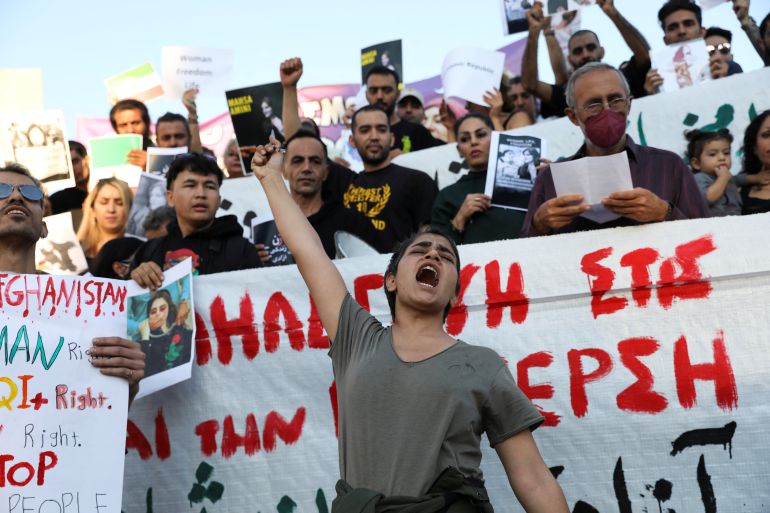Iran pledges ‘decisive action’ as Mahsa Amini protests continue
Iranian president’s warning comes as social media videos showed protesters back on the streets despite a crackdown that killed at least 41 people.

Iran’s President Ebrahim Raisi has pledged to deal “decisively” with the protests that have swept the country since the death of a woman who was detained by the Iranian morality police.
Raisi’s comments on Saturday came as protesters took to the streets for a ninth consecutive night, defying a crackdown in which at least 41 people have been killed, according to state television. It said the toll was based on its own count and official figures were yet to be released.
Keep reading
list of 4 itemsElon Musk greenlit to activate Starlink internet for Iranians
Ukraine to reduce Iran embassy presence over Russia drone attacks
US relaxes internet sanctions on Iran in support of protesters
Hundreds of people have also been arrested, with protests reported in most of the country’s 31 provinces.
State media said Raisi on Saturday spoke to a relative of the Basij paramilitary member who had been killed while taking part in a crackdown in the northeastern city of Mashhad. It quoted the president as saying that Iran must “deal decisively with those who oppose the country’s security and tranquillity”.
The president “stressed the necessity to distinguish between protest and disturbing public order and security, and called the events … a riot,” state media reported.
The protests broke out in northwestern Iran a week ago at the funeral of Mahsa Amini, a 22-year-old Kurdish woman who died after falling into a coma following her detention in Tehran by morality police enforcing hijab rules on women’s dress.
Her death has reignited anger over issues including restrictions on personal freedoms in Iran, the strict dress codes for women, and an economy reeling from sanctions.
Women have played a prominent role in the protests, waving and burning their veils. Some have publicly cut their hair as furious crowds called for the fall of Supreme Leader Ayatollah Ali Khamenei.
The protests have been the largest to sweep Iran since demonstrations over fuel prices in 2019 when the Reuters news agency reported 1,500 people were killed in a crackdown on protesters – the bloodiest confrontation in the country’s history.
On Friday, state-organised rallies took place in several Iranian cities to counter the anti-government protests, and the army promised to confront “the enemies” behind the unrest.
State television in Iran, which has accused armed exiled Iranian Kurdish dissidents of involvement in the unrest, said the Iranian Revolutionary Guard Corps had fired artillery on bases of Kurdish opposition groups in the Kurdish region of northern Iraq.
‘Spiralling deadly response’
At least three times this week, mobile internet has been disrupted in Iran, the NetBlocks watchdog has reported. Activists say the move is intended to prevent video footage of the violence from reaching the world.
On Saturday NetBlocks said Microsoft’s Skype video calling app was now restricted, the latest such measure after platforms including Instagram, WhatsApp and LinkedIn were targeted.
In an effort to help sustain internet connection, the United States is making exceptions to its sanctions regime on Iran – a move Tehran said on Saturday was in line with Washington’s hostile stance.
Rights group Amnesty International said protesters face a “spiralling deadly response from security forces” and called for an independent United Nations investigation.
On the night of September 21, shootings by security forces left at least 19 people dead, including three children, it said.
“The rising death toll is an alarming indication of just how ruthless the authorities’ assault on human life has been under the darkness of the internet shutdown,” Amnesty said.
State television showed footage purporting to show calm had returned to many parts of the capital Tehran late on Friday.
“But in some western and northern areas of Tehran and certain provinces, rioters destroyed public property,” it said, carrying footage of protesters setting fire to rubbish bins and a car, marching, and throwing rocks.
The activist Twitter account 1500tasvir carried videos of protests in Tehran’s western district of Sattarkhan showing protesters gathered at a square chanting: “Don’t be afraid, we are all in this together,” late on Saturday with a motorcycle apparently belonging to riot police burning in the background.
Another video, purportedly from Saturday evening, showed a woman defiantly swinging her headscarf above her head as she walked in the middle of a Tehran street.
Protests also took place in the northern city of Babol in Mazandaran province, according to footage on social media, with youths trying to tear down portraits of Khamenei and Ayatollah Ruhollah Khomeini, the founder of the Islamic Republic of Iran, from a university’s gate while bystanders cheered them on and shouted: “Death to the dictator.”
Protests also reportedly continue in the city of Rasht in Gilan province, where the police chief has announced the “arrest of 739 rioters, including 60 women” in that province alone. Other videos showed crows gathering in Sanandaj, the capital of Kurdistan province, late on Saturday, despite a heavy police presence.
The videos could not be verified independently.
Demonstrators also took to the streets of cities in Iraq, Germany, Greece, Sweden, the United Kingdom and the US on Saturday to express solidarity with Iranian protesters.
In Iraq, dozens of Iraqi and Iranian Kurds rallied outside the UN compound in the northern city of Erbil, carrying placards with Amini’s photograph and chanting: “Death to the dictator,” referring to Khamenei.